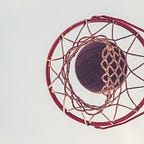Insights from MetaNet, the March Madness Neural Network for Bet Sizing
Like I did for the MadNet and BoxNet neural networks, I also used MetaNet, the March Madness meta-labeling neural network to experiment with randomly generated basketball dasta. In this case, just like for MadNet, I used randomly generated values for the advanced stats data that I’ve been using since my first March Madness Neural Network. Check out that blog post to learn about how I use these neural networks to predict a college basketball team’s “Wins Above Seeding” value (which can also take on negative values when a team underperforms relative to its seed).
First I took the existing data and changed the output to be 1 for teams with Wins Above Seeding greater than 4(corresponding to a team that goes on a really good run — a team seeded lower than 4 winning it all!).
Then I trained the same MetaNet neural network:
and used this neural network to predict the results of 500 different randomly generated team profiles:
The resulting array, which I named “winners”, had 6 entries, with the below values:
To figure out what stat category each array field corresponds to, you’ll need to see how I structured the data in my description of my original March Madness neural network. When I cross-referenced this data, one thing that really stood out is how these teams don’t all have a great win-loss record (in fact only one team has a win-loss greater than the 90th percentile), but they all have very good strength of schedules (all above roughly the 80th percentile). In addition, the teams all have a pace below the 50th percentile, a necessity for teams trying to pull off an upset since by limiting the number of possessions they give the other team less chances to run away with the game. In addition, all of these teams have a Free Throw Rate (the ratio of free throws attempted to field goals attempted) greater than the 50th percentile, and a Three Point Attempt rate greater than the 60th percentile. If you want to go on a run, it seems like you need to take threes and get to the line — an approach that’s very familiar for James Harden and the Houston Rockets.
I also ran 1,000 trials with randomly generated teams on a neural network trained to find underperforming teams with a WAS below -2. The 5 teams with a WAS this low are shown below:
We can see that these underperforming teams all tend to have a relatively low block rate and low steal rate, as well as a very low rebounding rate. It’s interesting that so many of these insights gleaned from March Madness machine learning show what kind of teams tend to get upset in March: those with a very high assist rate, a very low Free Throw attempt rate, and poor block rate and rebounding rate. Looking through this year’s likely high seed March Madness teams on Sports Reference, Creighton and Villanova both have very low block and rebounding rates, top 20 percentile assist rates. Villanova also suffers from the extra whammy of having a very low Free Throw attempt rate, making them a great under the radar upset candidate once the tourney starts!
